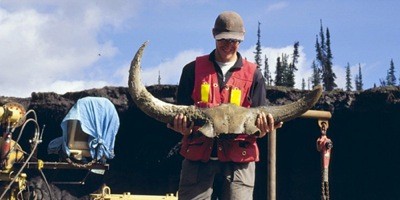For decades researchers have tried to pinpoint the cause of the massive loss of large-bodied Ice Age mammals, megafauna, about 10,000 years ago. The debate has largely focused on whether a particular mechanism was evident: was it humans and hunting? Climate and environmental change? An extraterrestrial impact? Or were the animals eliminated by a a hyperdisease, a disease that so impacted the population numbers there was no possibility of recovery.
But a new study detailing the history of six large herbivores—the woolly rhinoceros, woolly mammoth, wild horse, caribou, bison and muskox—shows that both climate change and humans were to blame for the extinction or near extinction of large-mammal populations within the last 10,000 years.
Duane Froese, a researcher in the University of Alberta’s Department of Earth and Atmospheric Sciences, was a contributor to the international study led by scientists at the University of Copenhagen. Froese describes the research as a massive effort where nearly 3,000 specimens of ice-age mammals were radiocarbon dated, and mitochondrial DNA sequences from ancient fossil specimens were analyzed. These data were the used to understand the responses of different ice-age megafauna to the pressures of early hunters and climate change.
“When you look at the large-scale population dynamics of the ice-age mammals sampled in this study,” said Froese, “the overarching driver is climate change, and populations of megafauna waxed and waned with changing climate.”
Froese said that, “the study puts an end to the single cause theories of ice-age extinctions.” He explains that all six of the species were cold-adapted animals that flourished when climate was cold during past glacial times, but probably experienced strong losses during periods of climate warming. The extent to which humans changed this pattern was the subject of the study.
The findings varied with animal type and location. While the researchers concluded climate change was directly responsible for the demise of the woolly rhino and muskox in Eurasia, ancient humans get the blame for the vanishing herds of wild horses and bison in Siberia. Bison survived and ultimately flourished in North America as climate warmed, but only in more southern locations, despite a large human presence. Reindeer and muskoxen managed to survive in Arctic North America despite overlapping with humans.
Froese said that the findings help to predict the fate of populations threatened by climate change and habitat alteration that is happening today.
“This study provides direct evidence that something changed at the end of the most recent glacial cycle when many species went extinct relative to previous cycles when they all managed to survive. Even with small numbers of people present at the end of the last ice age our ancestors managed to have strong impacts on natural communities.”
The research was published Nov. 2 in the online edition of the journal Nature.


